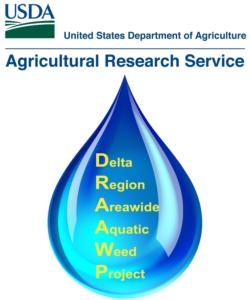From the Journal of Aquatic Plant Management—Special Issue Vol. 59s 2021
 New herbicides and tank mixes for control of waterhyacinth in the Sacramento–San Joaquin Delta
New herbicides and tank mixes for control of waterhyacinth in the Sacramento–San Joaquin Delta

Guy B. Kyser, John D. Madsen, John Miskella, and Jon O'Brien
Abstract
The Sacramento–San Joaquin Delta is the largest freshwater estuary on the West Coast of the United States. Delta habitat and economic utility are compromised by waterhyacinth, a floating aquatic weed. Standard control measures for waterhyacinth include foliar treatment with glyphosate or 2,4-D. We have conducted trials over three seasons to evaluate efficacy of newly registered, low–userate aquatic herbicides. In 2017, we evaluated waterhyacinth control using carfentrazone (133 g ai ha-1), flumioxazin (322 g ai ha-1), imazamox (280 g ae ha-1), and florpyrauxifen-benzyl (29.4 and 58.8 g ai ha-1), as well as various tank mixes, compared with a standard rate of glyphosate (1,681 g ae ha-1). Plots were established in floating 1-m2 quadrats, and treatments were replicated four times. All treatments were applied in 935 L ha-1 solution with 3.5 L ha-1 nonionic surfactant. We also included treatments with glyphosate (1,681 g ae ha-1) in lower spray volumes of 234 and 468 L ha-1. We collected biomass samples at 8 wk after treatment (WAT). Three treatments reduced waterhyacinth biomass by > 95%: florpyrauxifen-benzyl (58.8 g ai ha-1), flumioxazin + imazamox (322 + 280 g ai/ae ha-1), and the 468 L ha-1 application of glyphosate (1,681 g ae ha-1). Tank mixes (flumioxazin + imazamox, carfentrazone + imazamox, carfentrazone + glyphosate, and flumioxazin + glyphosate) gave approximately additive control. Florpyrauxifen-benzyl and flumioxazin + imazamox may be effective alternatives to glyphosate for controlling waterhyacinth with reduced rates of active ingredient. Glyphosate applied in a spray volume of 468 L ha-1 produced better control than the same rate of glyphosate in 935 L ha-1, suggesting that spray-volume optimization may be a useful topic for future research.
Delta Region Areawide Aquatic Weed Project website
Authors
- Guy B. Kyser, Specialist, Department of Plant Sciences, University of California, Davis (gbkyser@ucdavis.edu)
- John D. Madsen, Research Biologist, USDA–ARS ISPHRU, Department of Plant Sciences, University of California, Davis (jmadsen@ucdavis.edu)
- John Miskella, Biological Research Technician, USDA–ARS ISPHRU, Department of Plant Sciences, University of California, Davis (jmiskella@ucdavis.edu)
- Jon O'Brien, Environmental Program Manager, Department of Parks and Recreation, California State Parks